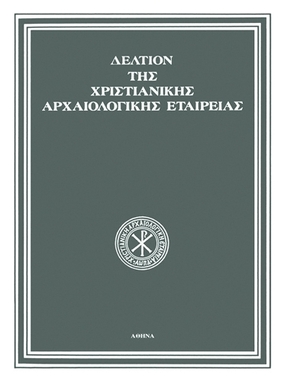Η σκηνή του «Μη μου άπτου», όπως εμφανίζεται σε βυζαντινά μνημεία και η μορφή που παίρνει στον 16ο αιώνα (πίν. 61-66)
Part of : Δελτίον της Χριστιανικής Αρχαιολογικής Εταιρείας ; Vol.21, 1964, pages 203-230
Issue:
Pages:
203-230
Parallel Title:
The «Noli me tangere» in Byzantine and Post-Byzanine Painting (pl. 61-66)
Section Title:
Articles
Abstract:
The scene of « Noli me Tangere » presents the apparition of Jesusto Mary Magdalene after the Resurrection, as described in St. John,2θ, n-18 , and, in lesser detail, in St. Marc, 16, 9- 11.In the usual representation Christ is standing on the right, tending his right hand towards Mary, who reaches to grasp it, but haltsreluctantly in compliance to his words «touch me not». We practically always find the empty tomb, sometimes inside the garden inwhich the scene takes place, guarded by two angels, later hewn outof the rocky mountainside in the background.The « Noli me Tangere » is hardly ever to be found before the12th century, while other scenes from the Cycle of the Resurrection,as for example the apparition of Jesus to both « Mary Magdalene andthe other Mary» (St. Matthew, 28, 1-10) are fairly frequent.It can be stated that until the 16th century the scene of « Nolime Tangere » is not presented according to some specifically laid - downtype, as happens with so many other scenes in byzantine painting.Inspiration for the representation is drawn alternatively from varioussimilar or relative scenes which had been familiar and more frequentlyencountered in early byzantine iconography. Thus, in Par. 74 (fig. 1)it is reminiscent of the scene of the apparition to both Mary Magdaleneand the other Mary as known from older works, e.g. Par. 510. Thesame scene is used as a prototype to the « Noli me Tangere » of theExultet Bibl. Mazarine 364 (fig. 3). In both these cases it is reproduced with the omission of the one woman. Alternatively, in theExultets Vat. Barb. Lat. 592 and Brit. Mus. Add. 30337 ( fig. 4 ) theposture of Christ has a direct counterpart in the scene of the Anastassis( Descent into Hell ) as found in Monreale, Nea Moni of Chios ( fig. 5 )and Hossios Loukas.Later, in Serbian frescoes (Staro- Nagoricmo (fig. 6), Graaanica),the « Noli me Tangere » has strong iconographie connections to theApparition to the Holy Women in Chilandarion ( fig. 7 ) and St. Nicholas Orphanos in Thessaloniki (PI. 61.2). Contrarily at Decani (fig. 8)the figures of Christ and Mary Magdalene can be closely correlated tothose of the Miracle of the Woman with the Issue of Blood in the manuscript Par. 54 (fig. 9). The same scene from the mosaics in thechurch of St. Saviour in Chora may have been used as a prototype forthe « Noli me Tangere » by Theophan the Greek in Volotovo ( fig. 10 ).From the early 16th century onwards the scene seems to be painted more and more after a specific pattern. This is evident from aseries of paintings dated within this period and characterized by strongwestern infuences, e.g. two icons of the Ermitage Collection in Leningrad (PI. 62.1 and 63.2), another in the Byzantine Museum in Athens(no. 1635, PI. 63.1), and a fresco in a church at Thari in Rhodes(PI. 64-1). Its final form, however, is given to it by masters of theCretan school in paintings of the Athos and Meteora monasteries(the Dionysiou Monastery of Athos, 1547, the Monastery of the Transfiguration, Meteora, 1552 (PI. 61.1 ), and the Dochiariou Monasteryof Athos, 1568). These frescoes keep in style and composition thecharacteristics of the Cretan school, i.e. absence of all narrativeelements, balance in composition, and adherence to the older byzantine patterns, as seen in the posture of Christ, the rugged mountainousbackground, the sarcophagos. Discretely, a number of western elements is now introduced, among others Christ's raised hand as aremnant of western representations where he is holding the cross, thewound of the lance in Christ's side, the bare - headed Magdalene andthe richer drapery of her mantle.The « Noli me Tangere » now becomes fairly popular and is foundrepeatedly in post - byzantine iconography, sometimes represented byimportant paintings, such as the icon by Michael Damascenos ( PI. 64.2)in St. Minas in Crete ; there the type of Athos is not followed strictly,however, insofar as more western elements are utilized for the figureof Mary Magdalene, while the background is animated with varioussecondary scenes.Outstanding examples of faithful adherence to the Athos typefrom the end of the 16th century are an icon of the Hellenic Institutein Venice, the center of a triptych in the Benaki Museum ( PI. 65.2 ),and another icon from Zante (PI. 65.1 ), destroyed by fire followingthe earthquake of 1953. These compositions are suffused by a deepreligious feeling, as well as a feeling of classical balance and austerity,while retaining at the same time profound human warmth.From the beginning of the 17th century, in the icons of Lambardos in Dudrovnic, one in the Orthodox Patriarchate of Jerusalem( PI. 66.1 ), in yet another from the Schiff Collection in Pisa, and finallyin one by Emmanuel Tzane ( PI. 66.2 ) in the Antivouniotissa Church in Corfu, begins a stylization, with a touch of added pathos in theexpressions, to which the diminishing refinement and elegance of theforms can be ascribed.The « Noli me Tangere » continues to be painted until the 18thcentury, sometimes faithful to the Athos type ( frescoes of Pyrghi inChios, and of Mavrilo), sometimes with obvious western affiliations(frescoes of the Theologos Church in Nicosia, by the painter Markosin the Moni Petraki in Athens, and the Phaneromeni in Salamis).Finally, we must mention a large number of works embellished withvarious elements, borrowed even from Damascenos : frescoes from Kaisariani and St. John Lambadist in Nicosia, an icon in Makrynitsa(PI. 62.3), another by the painter Hanna in the Byzantine Museumin Athens (PI. 62.2), and an iconostasis wooden door (fig. 11) fromKythera.
Subject:
Subject (LC):




